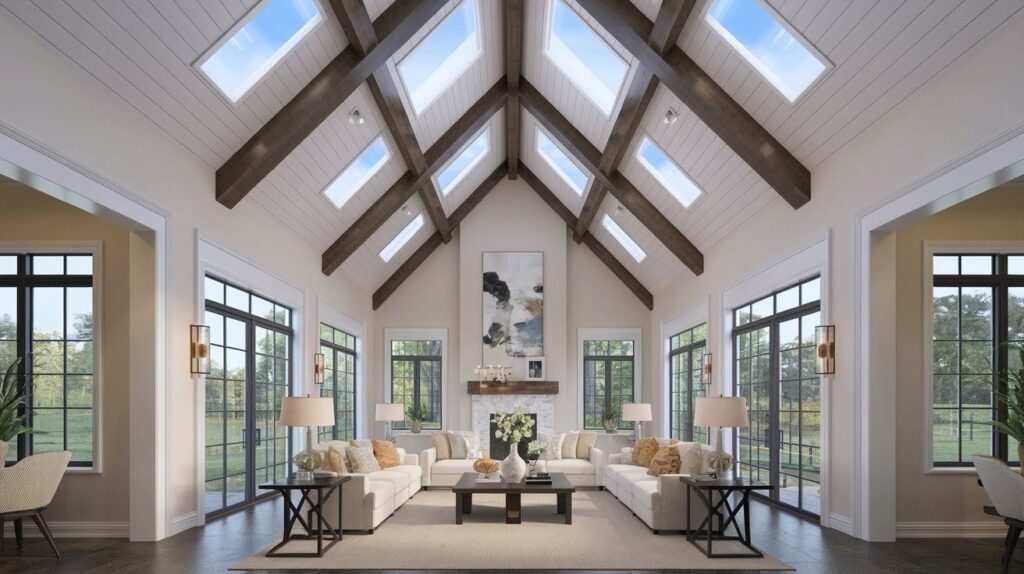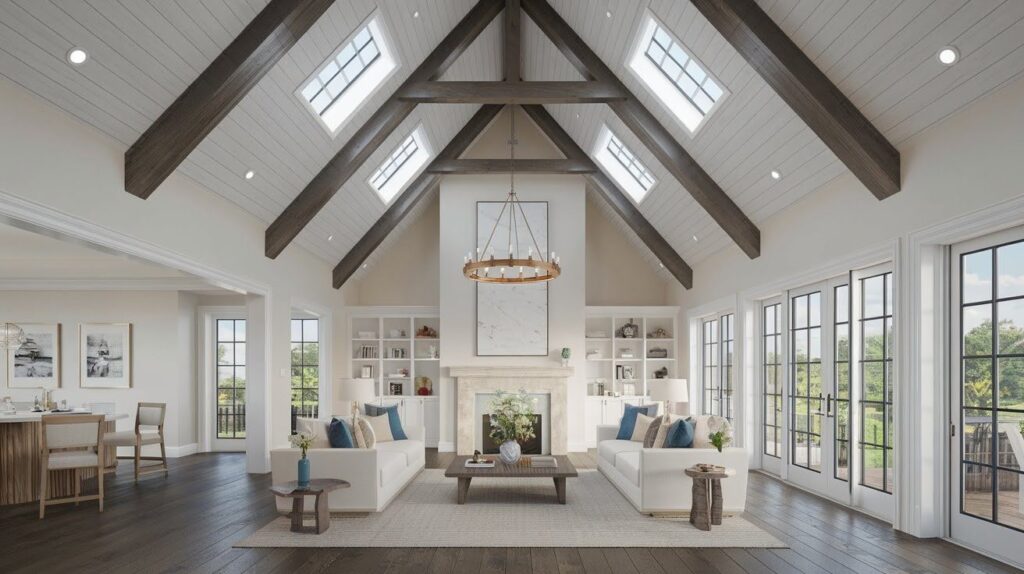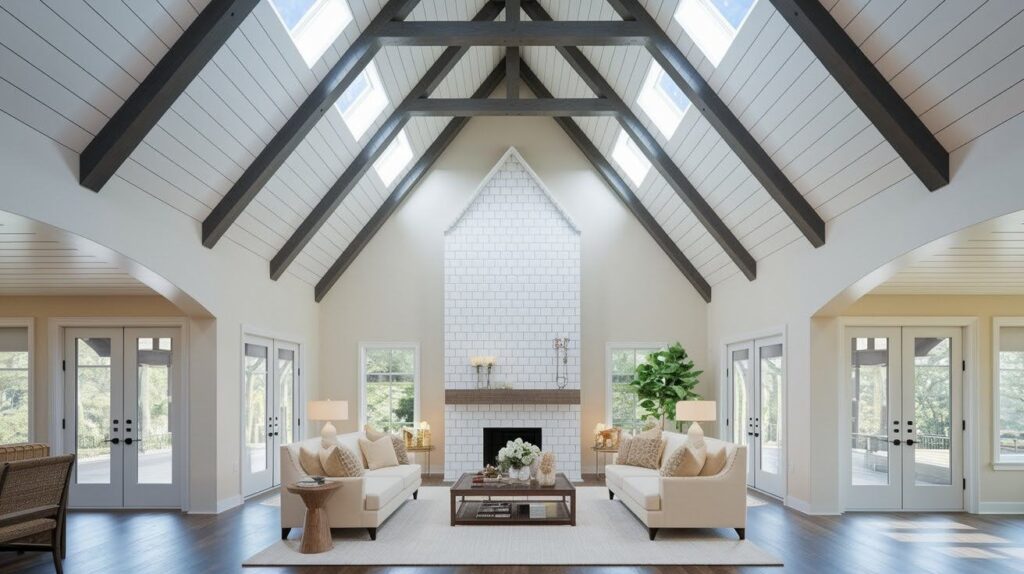Your ceiling affects how you feel in a room more than you realize. A low ceiling can make you feel cramped. A high one makes you feel free.
Cathedral ceilings create that feeling of freedom. They soar upward, following your home’s roofline.
Think about the last time you walked into a grand space. Maybe it was a hotel lobby or an old church. You probably looked up first. Your eyes naturally followed those soaring lines. That’s the magic of vertical space.
Cathedral ceilings bring that same impact to your home. They turn ordinary living rooms into showstoppers. They make small spaces feel massive. But they also come with challenges you need to understand.
You’ll see design ideas that work. By the end, you’ll know if this ceiling style fits your space and budget. Let’s start with the basics.
What Is a Cathedral Ceiling?

A cathedral ceiling slopes upward from both sides. It meets at a peak in the center. Think of an upside-down V shape.
This design follows your roof’s angle. No flat surface sits between the ceiling and the roof. The ceiling IS the underside of your roof structure.
How it differs from other ceilings:
- Flat ceilings: Completely horizontal
- Vaulted ceilings: Can be arched, domed, or angled (but don’t always follow the roofline)
- Cathedral ceilings: Always angled, always follow the roof pitch
The key is symmetry. Both sides slope at the same angle. They meet at the highest point of your room.
History & Origins

Cathedral ceilings get their name from where they started, actual cathedrals and churches.
Medieval builders created soaring spaces to inspire awe. High ceilings drew eyes upward toward heaven. The pointed arches and steep angles became signature features of Gothic architecture.
Fast forward to the 1960s. American builders brought this concept into homes. The post-war housing boom embraced open, dramatic spaces. Cathedral ceilings became symbols of luxury and modern living.
Today, they appear in everything from log cabins to contemporary mansions. The basic principle remains the same, create vertical drama and spacious feelings.
Key Features of Cathedral Ceilings

The defining characteristics include:
- High, sloping sides: Both sides angle upward from the walls. They create a triangular or peaked shape.
- Central ridge line: The highest point runs down the center of your room. This is where both sides meet.
- Follows roofline: The ceiling mirrors your roof’s pitch exactly. No attic space sits between them.
- Sense of openness: Rooms feel larger and more spacious. The eye travels upward, creating visual expansion.
- Optional beams – Some designs include exposed structural beams. Others keep them hidden for clean lines.
The height varies based on your roof pitch. Steeper roofs create taller cathedral ceilings.
Design Ideas for Homes with Cathedral Ceilings

1. Exposed Wood Beams for Rustic Charm
Wooden beams add character and warmth. They break up large ceiling expanses.
Choose reclaimed wood for authentic texture. Dark stains create drama. Light woods keep things airy.
Beams work great in:
- Living rooms
- Kitchens
- Bedrooms
2. Skylights for Natural Light
Cathedral ceilings are perfect for skylights. They sit high above, flooding rooms with light.
Position skylights strategically:
- Overseating areas in living rooms
- Above kitchen islands
- In master bedrooms for morning light
Consider automated blinds for light control.
3. Modern Minimalist Finishes
Clean lines emphasize the ceiling’s natural drama. White or light colors make spaces feel even larger.
Skip busy patterns. Let the architecture be the star.
Smooth drywall creates seamless surfaces. Paint everything the same color for continuity.
4. Statement Chandeliers or Pendant Lighting
High ceilings need proportional lighting. Small fixtures get lost in the space.
Consider:
- Large chandeliers as focal points
- Multiple pendant lights in a row
- Track lighting to wash walls with light
Hang fixtures at appropriate heights – usually 7-8 feet from the floor in living areas.
5. Accent Walls to Enhance Height
Vertical elements emphasize your ceiling’s height. Use them on the wall opposite your main seating.
Try:
- Stone or brick for texture
- Bold paint colors
- Wood paneling
- Built-in shelving that reaches up high
Visual tricks to emphasize vertical space:
- Hang artwork higher than normal
- Use tall, narrow furniture pieces
- Install floor-to-ceiling windows or curtains
- Paint the walls and ceiling the same light color
Pros & Cons of Having a Cathedral Ceiling
Pros of Cathedral Ceiling
- Dramatic and spacious feeling: Rooms feel much larger than their square footage. The vertical space creates an impressive first impression.
- More natural light: Higher ceilings allow for larger windows and skylights. Light bounces around the space better.
- Increased home value: Many buyers pay premium prices for cathedral ceilings. They’re associated with luxury homes.
- Luxury appearance: High ceilings suggest quality construction and upscale design. They make ordinary rooms feel special.
- Better air circulation: Hot air rises to the peak. This can improve comfort in some climates.
- Design flexibility: You have more wall space for large artwork, tall furniture, and creative lighting solutions.
Cons of Cathedral Ceiling
- Higher energy costs: Large volumes of air cost more to heat and cool. Hot air collects at the peak in winter.
- Expensive to build: Construction costs increase with complexity. Retrofitting existing homes costs even more.
- Maintenance challenges: Changing light bulbs requires tall ladders. Cleaning becomes difficult at peak heights.
- Sound issues: Voices can echo in large spaces. Hard surfaces amplify noise without proper acoustic treatment.
- Limited insulation space: Following the roofline can reduce insulation thickness. This affects energy efficiency.
- Furniture scale problems: Regular-sized furniture can look tiny. You may need larger pieces to fill the space properly.
Cathedral Ceiling vs Vaulted Ceiling
Cathedral ceilings:
- Always follow the roofline exactly
- Symmetrical slopes on both sides
- No attic space above
- Meet at a central peak
Vaulted ceilings:
- Can be arched, domed, or barrel-shaped
- Don’t always follow the roof pitch
- May have attic space above
- More varied design options
When to choose a cathedral: You want maximum height and dramatic impact. Your roof pitch creates good proportions.
When to choose vaulted: You need more design flexibility. You want to keep some attic storage space.
Is a Cathedral Ceiling Right for You?
Ideal home styles:
- Contemporary and modern designs
- Log homes and rustic styles
- Traditional homes with steep roof pitches
- Open floor plan layouts
Consider these factors:
- Climate: They work better in moderate climates. Extreme temperatures increase energy costs significantly.
- Budget: Factor in construction, energy, and maintenance costs. Cathedral ceilings are long-term investments.
- Space usage: They work best in the main living areas. Bedrooms might feel too grand for intimate settings.
- Lifestyle: Do you entertain often? Cathedral ceilings create impressive spaces for gatherings.
- Home size: Small rooms benefit most from the expanded feeling. Large rooms might become overwhelming.
Conclusion
Cathedral ceilings change ordinary rooms into extraordinary spaces. They create drama, light, and a sense of luxury that flat ceilings simply can’t match.
But they’re not right for every home or budget. Higher costs, maintenance needs, and energy usage are real considerations. You need to consider the visual impact against practical concerns.
The best cathedral ceilings feel natural in their space. They enhance your home’s architecture without overwhelming it.
Remember, your home should reflect your lifestyle and priorities. Cathedral ceilings work best when they serve your daily needs, not just your design dreams. Consider how you use your space before making major changes.
Take an honest look at your goals, budget, and lifestyle. If you want a dramatic impact and can handle the trade-offs, cathedral ceilings might be perfect for you. If you prioritize efficiency and simplicity, stick with tradition.
Frequently Asked Questions
How much does it cost to add a cathedral ceiling to an existing room?
Expect to pay $15,000-$30,000 or more for a typical living room. The project involves removing the existing ceiling, modifying the roof structure, adding insulation, and finishing work. Costs vary significantly based on room size and structural requirements.
Do cathedral ceilings make rooms harder to heat and cool?
Yes, they increase energy costs by 10-25% in most homes. Hot air rises to the peak, making heating less efficient. Cooling costs also increase due to the larger air volume. Ceiling fans help circulate air and reduce energy usage.
What’s the minimum roof pitch needed for a cathedral ceiling?
Most cathedral ceilings need at least a 6/12 pitch (6 inches of rise per 12 inches of run). Lower pitches don’t create enough dramatic height. Steeper pitches like 8/12 or 10/12 work even better for visual impact.
Can I install a cathedral ceiling in a ranch-style home?
It’s possible but challenging. Ranch homes typically have low roof pitches and wide spans. You might need additional structural support. The final height may be limited by the original roof design. Consult a structural engineer first.
How do I reduce echo in a room with cathedral ceilings?
Add soft materials like area rugs, curtains, and upholstered furniture. Consider acoustic panels on walls. Exposed wood beams also help break up sound waves. Avoid too many hard surfaces like tile or hardwood without soft elements to balance them.

